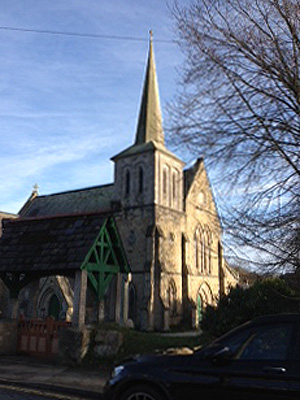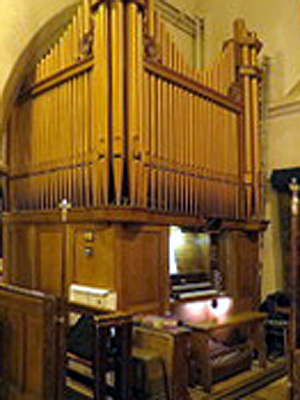| |
 |
 |
 |
| Comment on this report, or find other reports. |
 |
| Our Mystery Worshippers are volunteers who warm church pews for us around the world. If you'd like to become a Mystery Worshipper, start here. |
 |
| Find out how to reproduce this report in your church magazine or website. |
|
|
| 3101: St Paul’s, Charlestown, England |
 |
 |
 |
Mystery Worshipper: Werburga of Chester.
The church: St Paul’s, Charlestown, Cornwall, England.
Denomination: Church of England, Diocese of Truro.
The building: A Victorian stone building that dates from 1851. It was designed by the London architect Christopher Eales, known for his market buildings and workhouses. The foundation stone was laid in 1849 and the new church was consecrated on 30 May 1851. However, the building fund had run out of money because of a downturn in the mining industry, and a planned spire was not completed until 1971, when a belfry and steeple were added. As a nod to modern construction techniques, the steeple is of fibreglass although the belfry itself is of stone and slate. A ring of six bells was blessed by the Bishop of Truro. The treble bell is called Noel because it was donated by Noel Coward.
Inside, the nave is wide and the transepts short, so the floor plan is a chunky cross, commanded by a substantial crucifix standing on a rood screen with large figures of the Virgin Mary and Mary Magdalene looking up at Our Lord. Below this for Christmas there hung a substantial Christmas garland. The north transept is also the Lady chapel, containing another statue of Our Lady, this one holding the infant Christ. On this Christmas Eve the chapel also contained a very large model of a Christingle orange, presumably used as a visual aid for a Christingle family service held earlier in the day.
The church: The parish shares a priest with the adjacent parish of Par but both are currently between incumbents: a new parish priest will be arriving in February 2017. At least one mass is celebrated on Sundays, at 9.30am, with an additional 7.45 Book of Common Prayer service on the first Sunday of the month, on which the 9.30 service is a family eucharist. There is an active social calendar of events, including regular Bible study. The church runs Open the Book, an approach to presenting the Christian faith in schools.The parish is registered as a fair trade parish for the sale and use of tea, coffee and sugar.
The neighbourhood: Charlestown is located on the south coast of Cornwall, between the town of St Austell and the port of Fowey. It was originally a small fishing village on St Austell Bay, but in the late 18th century the area inland rapidly developed into a mining and industrial area. Charles Rashleigh (1747-1823), after whom Charlestown is named, was a member of an important local family who lived near Fowey. He planned much of the harbour to facilitate the safe shipping for export of copper ore, china clay and china stone, all mined locally, and for the import of coal and timber for industrial purposes. Subsequent decline of mining led to many people moving away, but this insulated Charlestown from aggressive development, and because of its period charm the harbour has more recently attracted film crews. Several square-rigged ships are currently based here and the village is now a conservation area, so recent residential development has been sensitively planned. Older buildings around the harbour have been adapted for purposes of tourism, including a Shipwreck and Heritage Centre and good places to eat, though the port is still a working port.
The cast: An energetic visiting priest (presumably retired from regular ministry), who said he’s been a priest in Cornwall for many years but who did not reveal his name. He donned a festive red and gold cope as he blessed the crib and then changed into a gold chasuble for mass. Also contributing were the organist and choirmaster, Paul Manuel, and a robed choir of six women. The choir sang from the back of the church, which is an odd place for a choir, but it was very helpful for those in the congregation who may not have been familiar with the mass setting.
The date & time: Christmas Eve, 24 December 2016, 11.30pm.
What was the name of the service?
Blessing of the Crib and First Mass of Christmas.
How full was the building?
Pretty full. Some seats toward the front were free, but the rest of the nave was packed and both side aisles were full as well.
Did anyone welcome you personally?
Yes. Two men were handing out service sheets and carol booklets. One, who was wearing a very bright festive Christmas-themed tie, smiled as he handed over the booklets and a candle (unlit) and candle-holder.
Was your pew comfortable?
Chairs, not pews, a bit short on knee-room but otherwise comfortable enough. There were kneeler cushions available, stored under the chairs in front, but there wasn’t room to kneel without the risk of getting stuck.
How would you describe the pre-service
atmosphere?
Friendly. People on either side of me were inclined to chat and others in the congregation were quietly chatting too. And the church was interesting to look at. It was generously decorated with candles: there were candles all round the tops of all the nave pillars, which were also girdled with greenery. There were also candles along all window-ledges in the nave and transepts, six fat candles on the nave altar, and six tall candles on the high altar. The lights were dimmed before the opening procession, and everyone had to light their own candles, at which point the atmosphere became one of quiet but intense anticipation.
What were the exact opening words of the
service?
"We sing carol number 16: 'Once in Royal David’s City.'"
What books did the congregation use during the
service?
Service booklet and a booklet of Christmas carol words. Sadly, some of these words were altered from the original, presumably in the name of gender-neutral language, as if that’s an excuse for altering anyone’s original poetry.
What musical instruments were played?
Organ, an opus of Hele & Co. of Plymouth and originally installed in Duporth House, the home of Charles Rashleigh. It was moved to its present location in 1930. Modifications were made over the years, most notably in 1995.

Did anything distract you?
The lights over the crib, decorating the stable roof, kept fading in and out in different colours. This was on the edge of my forward vision and quite distracting though eventually I got used to it.
Was the worship stiff-upper-lip, happy clappy, or
what?
Anglican high church, so definitely not happy clappy, but not particularly stiff-upper-lip either. People who felt inclined to do so were genuflecting or making the Sign of the Cross, and there was a procession with the priest wearing a cope, but the occasion did not feel stiff. I think this was because the priest kept emphasising how pleased he was to see us all there, and he was very helpful indeed in telling us what to do, what would come next, and what the local practice was in terms of sitting, standing, etc., so the service felt comfortable.
Exactly how long was the sermon?
13 minutes.
On a scale of 1-10, how good was the preacher?
9 – It’s hard to say something original about Christmas but the visiting priest managed it! He used visual aids (a shepherd’s crook and the chasuble he was wearing), as well as music, to reinforce his arguments, and he kept changing direction and throwing in the odd humorous comment. It was essential to pay attention or one might have missed something.
In a nutshell, what was the sermon
about?
The previous hymn had been "While shepherds watched their flocks by night," sung to a tune (Lyngham) traditional to Cornwall but not well-known outside. He pointed out that the carol probably has more tunes than any other carol, and that different villages used to have their own tunes. When those tunes are not handed on down through the generations, they are lost. He then asked if we saw ourselves as part of history. Do we share the good news of Jesus? Because if we don’t, it will be lost.
Which part of the service was like being in
heaven?
Lots of things. The candlelight was magical. It gave continuity to the event, for so must the Victorian parishioners have worshipped when the church was built. They formed a symbol of the entire service. The emphasis on welcome was strong, and Christmas is Christmas after all. I also very much appreciated the priest saying at the end that he hoped all visitors would take the parish’s greetings to their own parishes when they returned home.
And which part was like being in... er... the other place?
The incense used had a strong, rather unusual floral scent. At times of generous thurible-swinging it was hard to resist sneezing – and I did not always succeed! There was also a very difficult moment during the prayers when we were invited to sing "Silent night" unaccompanied. To my right a lady drifted off into a different key; to my left a gentleman attempted an improvised harmony that was in yet another key. A multi key-centred "Silent night," I discovered, does not sound good.
What happened when you hung around after the service looking lost?
Not possible to look lost. The priest was shaking hands with everyone going home, which meant a long queue, and people filled in time chatting to their neighbours (including me) and helping to sort service books and carol sheets and used candles into piles. Someone outside the church wished me happy Christmas as I left.
How would you describe the after-service
coffee?
No coffee. At 1.00am it was well past bed-time after all, and we needed to be home before Santa Claus came by! But the parish endorses fair trade and offers coffee after the Sunday 9.30 eucharist so one has to assume that is fair trade.
How would you feel about making this church your regular (where 10 = ecstatic, 0 = terminal)?
8 – I could easily be very keen on regularly worshipping here, given how much trouble people had obviously taken to decorate the church, and how friendly they were. But I would want to meet the new priest arriving in February before making a decision – a new priest can make quite a difference to a parish’s style.
Did the service make you feel glad to be a
Christian?
Very much so.
What one thing will you remember about all this in seven days' time?
That wonderful moment when the electric lights were switched off and the service commenced and continued in candlelight. |
|
|
 |
 |
 |
| We rely on voluntary donations to stay online. If you're a regular visitor to Ship of Fools, please consider supporting us. |
 |
 |
 |
| The Mystery Pilgrim |
 |
| One of our most seasoned reporters makes the Camino pilgrimage to Santiago de Compostela in Spain. Read here. |
 |
 |
 |
| London churches |
 |
| Read reports from 70 London churches, visited by a small army of Mystery Worshippers on one single Sunday. Read here. |
| |
|
|
|
|


